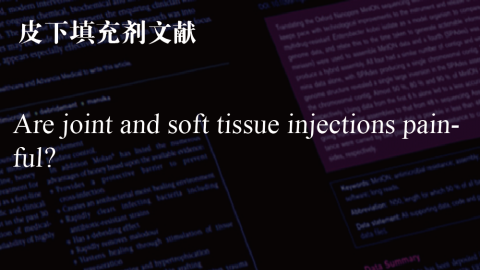
- 3096人
- 分享收藏
Are joint and soft tissue injections painful?
简介
【 文献重点摘要 】
Background: Joint, spinal and soft tissue injections are commonly performed by rheumatologists in their daily practice. Contrary to other procedures, e.g. performed in pediatric care, little is known about the frequency, the intensity and the management of procedural pain observed in osteo-articular injections in daily practice.
Methods: This observational, prospective, national study was carried out among a French national representative database of primary rheumatologists to evaluate the prevalence and intensity of pain caused by intra-and periarticular injections, synovial fluid aspirations, soft tissue injections, and spinal injections. For each physician, data were collected over 1 month, for up to 40 consecutive patients (>18-years-old) for whom a synovial fluid aspiration, an intra or peri-articular injection or a spinal injection were carried out during consultations. Statistical analysis was carried out in order to compare patients who had suffered from pain whilst undergoing the procedure to those who had not. Explanatory analyses were conducted by stepwise logistic regression with the characteristics of the patients to explain the existence of pain.
Results: Data were analysed for 8446 patients (64% female, mean age 62 ± 14 years) recruited by 240 physicians. The predominant sites injected were the knee (45.5%) and spine (19.1%). Over 80% of patients experienced procedural pain which was most common in the small joints (42%) and spine (32%) Pain was severe in 5.3% of patients, moderate in 26.6%, mild in 49.8%, and absent in 18.3%. Pain was significantly more intense in patients with severe pain linked to their underlying pathology and for procedures performed in small joints. Preventative or post-procedure analgesia was rarely given, only to 5.7% and 36.3% of patients, respectively. Preventative analgesia was more frequently prescribed in patients with more severe procedural pain.
Conclusion: Most patients undergoing intra-or peri-articular injections, synovial fluid aspirations and spine injections suffer from procedural pain. Most patients experience usually mild procedural pain and procedural pain management is uncommonly provided by physicians. Specific research and guidelines for the management of procedural pain related to rheumatologic care should be established to improve the quality of care provided by physicians.
背景:关节、脊柱和软组织注射通常由风湿科医生在日常工作中进行。与其他程序相反,例如在儿科护理中,人们对日常实践中骨关节注射中观察到的程序性疼痛的频率、强度和管理知之甚少。
方法:这项观察性、前瞻性、全国性的研究是在法国国家初级风湿病医生代表性数据库中进行的,目的是评估关节内和关节周围注射、滑液吸入、软组织注射和脊柱注射引起的疼痛的患病率和强度。对于每位医生,收集了超过1个月的数据,多达40名连续的患者(>18岁)在会诊期间进行了滑液抽吸、关节内或关节周围注射或脊柱注射。进行了统计分析,以便将在接受手术时遭受疼痛的患者与没有疼痛的患者进行比较。根据患者的特点,采用逐步Logistic回归进行解释分析,解释疼痛的存在。
结果:对240名医生招募的8446名患者(女性占64%,平均年龄62±14岁)的数据进行了分析。主要注射部位为膝关节(45.5%)和脊柱(19.1%)。80%以上的患者经历了以小关节(42%)和脊柱(32%)最常见的程序性疼痛。重度疼痛占5.3%,中度疼痛占26.6%,轻度疼痛占49.8%,无痛占18.3%。与其潜在病理相关的严重疼痛和在小关节进行手术的患者的疼痛明显更强烈。预防性镇痛和术后镇痛很少,分别为5.7%和36.3%。程序疼痛越严重的患者,预防性镇痛的次数越多。
结论:大多数接受关节内或关节周围注射、滑液抽吸和脊柱注射的患者都存在程序性疼痛。大多数患者通常会经历轻微的程序性疼痛,而程序性疼痛的管理很少由内科医生提供。应建立与风湿病护理相关的程序性疼痛管理的具体研究和指南,以提高医生提供的护理质量。



